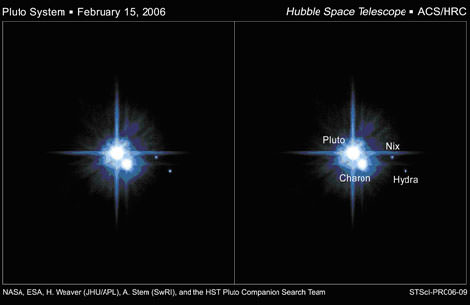[/caption]
With the New Horizons spacecraft on its way to Pluto, there may be an intriguing additional task for the mission’s science team: look for a potential ring around Pluto and its moons. Researchers at The Universidade Estadual Paulista in Brazil have recently submitted a paper for publication in which they explore the possibility of a ring system around the Pluto-Charon system. In their paper, the team discusses the effects of micrometeoroid impacts on Nix and Hydra and how the resulting dust particles could form a ring around Pluto. The team also investigates forces, such as the solar wind, which would dissipate said ring system.
Pryscilla Maria Pires dos Santos and her team provide an exhaustive list of calculations in their paper which estimates the ring system to have a diameter of nearly 16,000 kilometers – well outside the orbits of Nix and Hydra. Based on their calculations, Pires dos Santos state that despite nearly 50% of the ring’s mass being dissipated within a year, a tenuous ring system can be maintained by the dust expelled by micrometeoroid impacts.
Additional data presented in the paper places the rings “optical depth” as being several orders of magnitude fainter than even Jupiter’s rings. (Yes, Jupiter has a ring system!) While ground-based observatories and even the Hubble Space Telescope haven’t detected the ring system Pires dos Santos et al. are hopeful that the New Horizons mission will provide data to validate their theoretical models. New Horizons has a dust counter capable of measuring dust grains with a minimum mass of 10-12 grams, which should provide the data required to support or refute the team’s models.
Pires dos Santos mentions: “It is worth to point out that the interplanetary environment in the outer Solar System is not well known. Many assumptions have to be made in order to estimate a normal optical depth of a putative ring encompassing the orbits of Nix and Hydra.”
If you’d like to read the full paper, you can access it (for free) at: http://arxiv.org/PS_cache/arxiv/pdf/1108/1108.0712v1.pdf
Source: arXiv:1108.0712v1 [astro-ph.EP]


It seems very strange that a solar system body with no less than three moons and a possible ring system is not qualified to be a “planet”
I’d almost go so far as to say the Pluto-Charon system (Charon isn’t really a moon of Pluto – Pluto and Charon are a binary system) is a loose “cloud” of icy bodies/dust and less a planetary system. Regardless of planetary status, Pluto and the rest of the Kuiper Belt Objects are very much worth studying, so as to give us a better understanding of the outer solar system.
I agree. It is likely our definition of a planet needs some clarification if not outright modification. As we find more worlds, we might have to look into diversifying the term “planet.”
I believe that was what happened.
First exoplanets, since we can’t observe an characterize them as planets. Then the new definitions of planets & dwarfs. And no doubt there will be more to come.
I’m fairly sure the same happened with stars: the classical series, neutron stars, black holes, brown dwarfs…
It doesn’t seem all that strange to me. I’m perfectly happy with a system of eight classical planets and, in the words of They Might Be Giants, “a bunch of other stuff.” Pluto, Charon, Ceres, Eris, Sedna, and the other minor planets are just as interesting and just as worthy of study now as they were before they were re-categorized.
Earth doesn’t have rings – so should we strike that from the list then?
Neither Mercury nor Venus have moons – so they’ll have to go, too.
But plenty of asteroids have moons, so I guess we can make them planets instead of the three we lose this way.
I can’t wait until 2015!